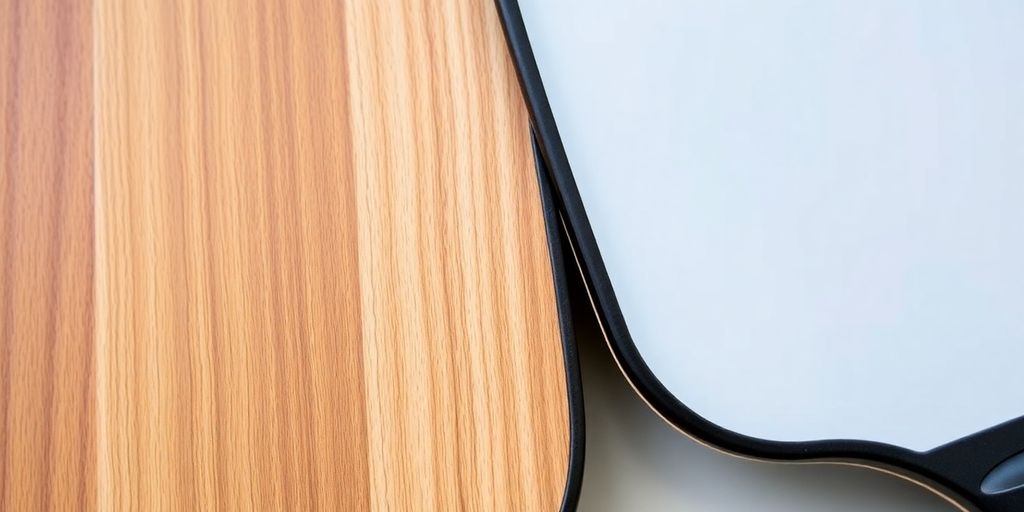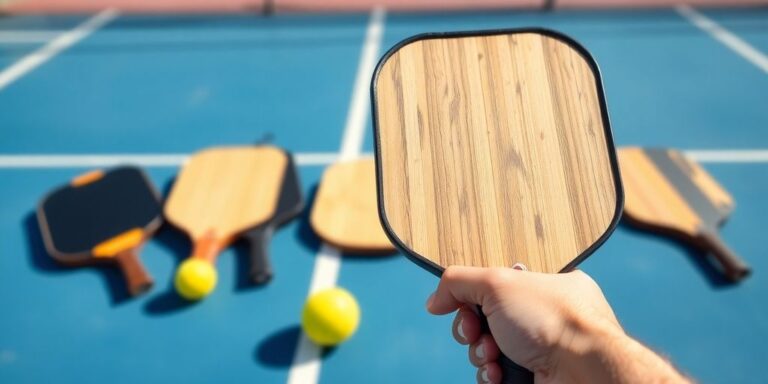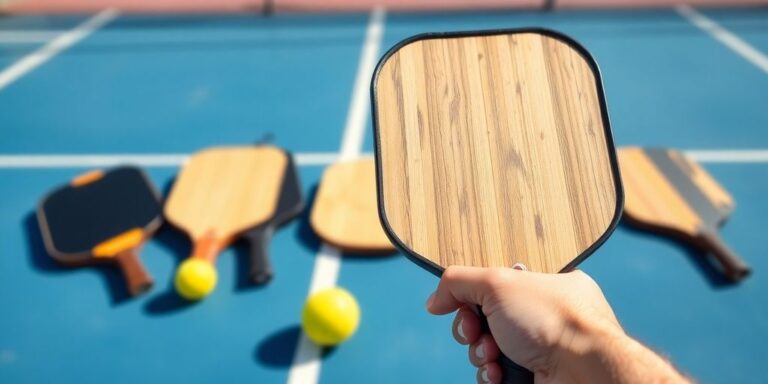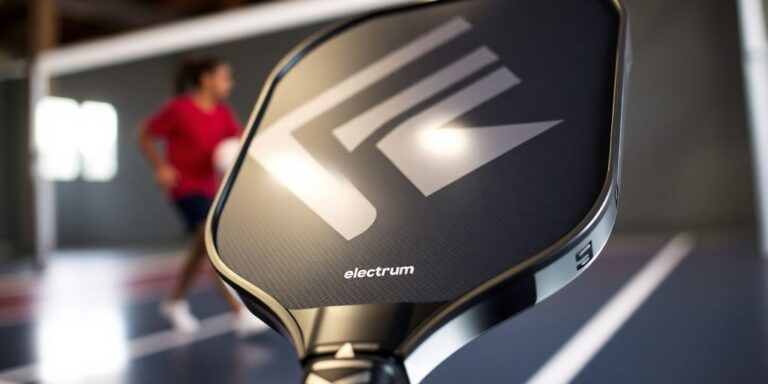When it comes to choosing a pickleball paddle, the material can make a big difference in your game. Wood and plastic paddles each have their own set of characteristics that can impact how you play. In this article, we’ll explore the differences between wood vs plastic pickleball paddles, helping you decide which is better for your style and skill level.
Key Takeaways
- Wood paddles are heavier and provide more power but can lack control.
- Plastic paddles are lighter and offer better maneuverability and control.
- Beginners may benefit from wood paddles due to their durability and affordability.
- Advanced players often prefer plastic paddles for their performance and responsiveness.
- Consider your playing style and budget when choosing between wood and plastic paddles.
Understanding Wood Pickleball Paddles

Characteristics of Wood Paddles
Wood paddles are the old-school choice, and while they might not be the top pick for serious players these days, understanding them is still worthwhile. They’re generally heavier than paddles made from other materials. This weight can affect how quickly you can react at the net and can tire your arm out during longer matches. Wood paddles also tend to have a larger surface area, which can be good for beginners still learning to make consistent contact with the ball. However, the hitting surface isn’t always uniform, which can lead to inconsistent shots.
Advantages of Using Wood
Despite the rise of newer materials, wood paddles still have some things going for them:
- Affordability: Wood paddles are usually the most budget-friendly option. If you’re just starting out and not ready to invest a lot of money, a wood paddle is a good way to get into the game. Check out these affordable pickleball paddles for options.
- Control: The weight and feel of wood can give you a good sense of control over the ball, especially for dinks and dropshots. This can be helpful as you develop your technique.
- Durability: Wood paddles are pretty tough. They can withstand a lot of use and abuse, which is great if you’re hard on your equipment.
Using a wood paddle can be a good way to learn the fundamentals of pickleball. The heavier weight forces you to use proper technique, and the emphasis on control can help you develop a more strategic game. It’s a great starting point before moving on to more advanced paddle materials.
Disadvantages of Wood Paddles
While wood paddles have their benefits, they also come with some drawbacks:
- Weight: As mentioned earlier, the weight can be a disadvantage, leading to fatigue and slower reaction times. This is especially noticeable during fast-paced games.
- Power: Wood paddles don’t offer as much power as paddles made from composite materials like graphite or carbon fiber. You might find it harder to hit deep shots or put the ball away with authority. Consider the impact of paddle thickness on your game.
- Sweet Spot: The sweet spot (the area on the paddle that gives you the best response) is smaller on wood paddles. This means you need to make more precise contact to get consistent results.
Exploring Plastic Pickleball Paddles
Plastic pickleball paddles have really shaken things up in the sport. They offer a different feel and performance compared to traditional wood paddles, and there’s a lot to consider before choosing one. Let’s dive into the world of plastic paddles and see what they’re all about.
Types of Plastic Paddles
When we talk about plastic paddles, we’re really talking about paddles with a plastic core, often paired with a composite face. The most common types you’ll find are:
- Polymer Core Paddles: These are super popular because they offer a good balance of power and control. The "honeycomb" structure inside helps dampen vibrations and provides a consistent feel.
- Nomex Core Paddles: Nomex is a type of aramid fiber, and these cores are known for their power and responsiveness. They tend to be louder than polymer cores.
- Composite Face Paddles: The paddle face can be made of fiberglass or carbon fiber, each affecting the paddle’s feel and performance. Fiberglass offers more flex, while carbon fiber is stiffer and provides more power. Choosing the right paddle material is important.
Benefits of Plastic Paddles
Plastic paddles have a lot going for them. Here are some of the key advantages:
- Lightweight: Generally, plastic paddles are lighter than wood paddles, which can improve your reaction time and reduce fatigue.
- Larger Sweet Spot: The construction of plastic paddles often results in a larger sweet spot, making off-center hits more forgiving.
- Variety of Options: There’s a huge range of plastic paddles available, with different core materials, face materials, and weights, so you can really fine-tune your paddle to your playing style.
Plastic paddles have become a favorite for many players due to their combination of performance and affordability. The technology behind these paddles continues to evolve, offering improvements in power, control, and durability.
Drawbacks of Plastic Paddles
Of course, plastic paddles aren’t perfect. Here are a few potential downsides:
- Can Feel Less "Solid": Some players miss the solid feel of a wood paddle and find plastic paddles feel a bit too light or hollow.
- Durability Concerns: While many plastic paddles are durable, some of the cheaper models may not hold up as well as a good wood paddle over time. Consider the paddle shapes when thinking about durability.
- Price Range: While there are affordable options, high-end plastic paddles can be quite expensive, sometimes more so than wood paddles.
Performance Comparison: Wood vs Plastic Pickleball Paddles
Power and Control Dynamics
Okay, so when it comes to power, plastic paddles generally have the edge. They often allow you to hit the ball with more force, which can be great for aggressive plays. Wood paddles, on the other hand, tend to offer more control. This means you can place the ball more precisely, which is super useful for dinking and strategic shots. It’s a trade-off, really. Do you want raw power, or do you want finesse?
Weight and Maneuverability
Weight is a big deal in pickleball. Wood paddles are usually heavier than plastic ones. This extra weight can give you more power, but it can also slow down your reaction time and make it harder to maneuver the paddle quickly. Plastic paddles are lighter, making them easier to swing and control, especially during fast-paced rallies. If you’re just starting out, a lighter paddle might be easier on your arm and wrist. For selecting lightweight pickleball paddles, consider how long you’ll be playing and your current strength level.
Durability and Longevity
Durability is where things get interesting. Wood paddles can be pretty tough, but they’re also susceptible to damage from moisture and impact. If you’re not careful, they can crack or warp over time. Plastic paddles are generally more resistant to the elements and can withstand more abuse. However, the surface of a plastic paddle can wear down over time, affecting its performance. So, while a plastic paddle might last longer, it might not perform as well as a wood paddle over its entire lifespan. Choosing the right Franklin Pickleball paddles can significantly impact your game’s longevity and performance.
Ultimately, the best paddle for you depends on your playing style, skill level, and personal preferences. There’s no one-size-fits-all answer. It’s worth trying out different paddles to see what feels best in your hand and what helps you play your best game.
Choosing the Right Paddle for Your Skill Level
It’s easy to get lost in the weeds when you’re trying to pick a pickleball paddle. There are so many options! But one of the most important things to think about is your current skill level. What works for a total newbie might hold back a more experienced player, and vice versa. Let’s break it down.
Beginners and Wood Paddles
For those just starting out, wood paddles can be a solid choice. They’re generally more affordable, which is great if you’re not ready to invest a ton of money into a new hobby. Plus, the heavier weight of wood paddles can actually help beginners develop a better feel for the ball and improve their control. It’s all about learning the basics, and wood paddles offer a forgiving platform to do just that. You can find some of the best pickleball paddles for beginners online.
Intermediate Players and Plastic Paddles
Once you’ve got the fundamentals down, it might be time to consider a plastic paddle. Plastic paddles, especially those with polymer cores, offer a nice balance of power and control. This can help intermediate players take their game to the next level. They’re also lighter than wood paddles, which can improve your reaction time and allow for quicker movements on the court.
Advanced Players’ Preferences
Advanced players often have very specific preferences when it comes to paddles. They might prefer carbon fiber paddles for their exceptional power and responsiveness, or they might stick with a particular type of plastic paddle that complements their playing style. At this level, it’s all about fine-tuning your equipment to maximize your performance. These players understand their skill level and what they need from a paddle to compete effectively.
Choosing a paddle is a personal journey. What works for one player might not work for another. Don’t be afraid to experiment with different materials and weights until you find the perfect fit for your game. Consider demoing paddles before you buy, if possible. Most importantly, have fun and enjoy the process of finding the right paddle for you!
Cost Considerations in Paddle Selection
Price Range of Wood Paddles
Okay, let’s talk money. Wood paddles are generally the most budget-friendly option out there. You can often find them for under $30, sometimes even less if you’re lucky and catch a sale. These are great for beginners or anyone just wanting to try out pickleball without a huge investment. Don’t expect top-tier performance, but they’re perfectly functional for casual play. The lower price point makes them accessible, but remember, you often get what you pay for in terms of durability and performance. If you are looking for a budget-friendly option, wood paddles are the way to go.
Price Range of Plastic Paddles
Plastic paddles, especially those with composite cores, tend to sit in the mid-range price bracket. You’ll typically find them anywhere from $30 to $100. The price varies depending on the quality of the materials used and the brand. Paddles with advanced polymer cores or special surface textures will usually be on the higher end. You’re paying for improved performance, better control, and often increased durability compared to wood paddles. For players who are past the beginner stage and want something that will last and perform well, plastic is a solid choice.
Value for Money Analysis
So, which paddle gives you the best bang for your buck? It really depends on your needs and how often you play. If you’re just starting out and playing occasionally, a wood paddle is a great value. It’s cheap, gets the job done, and lets you see if you even like the sport without breaking the bank. However, if you’re playing regularly and want to improve your game, investing in a plastic paddle is probably worth it. You’ll get better performance, more control, and a paddle that will likely last longer. Consider it an investment in your enjoyment and skill development. Think about paddle features before making a decision.
Ultimately, the ‘best’ value isn’t just about the lowest price. It’s about finding the paddle that meets your needs, fits your budget, and helps you enjoy the game the most. Consider how often you’ll play, your skill level, and what you want to get out of your pickleball experience. This will help you determine which paddle offers the best value for you.
Here’s a quick comparison table:
| Feature | Wood Paddles | Plastic Paddles |
|---|---|---|
| Price | Low | Mid |
| Durability | Low | Medium to High |
| Performance | Basic | Improved |
| Best For | Beginners | Intermediate |
| Value for Money | High (entry) | Good (overall) |
Impact of Paddle Material on Playing Style

Aggressive Play with Plastic
Plastic paddles, especially those with fiberglass faces, tend to offer more power. This makes them suitable for players who like to play aggressively at the net, driving the ball hard and fast. The stiffness of the material helps to transfer more energy to the ball, resulting in powerful shots. However, this power can sometimes come at the expense of control. If you’re all about slamming the ball, a plastic paddle might be your go-to. It’s worth considering how paddle materials affect your game.
Control-Oriented Play with Wood
Wood paddles generally provide more control and a softer feel. This is because wood absorbs more of the ball’s impact, allowing for better placement and dinking. Players who prefer a finesse game, focusing on strategic shots and ball placement, often find wood paddles to be a better fit. They allow for a more delicate touch, which is useful for drop shots and resets. It’s all about finding that sweet spot for pickleball skill ratings.
Hybrid Options for Versatility
Hybrid paddles combine different materials to offer a balance of power and control. For example, a paddle with a fiberglass face and a polymer core might provide a good mix of power for aggressive shots and control for finesse plays. These paddles are ideal for players who want to be versatile and adapt their game to different situations. They allow you to switch between power and control as needed, making you a more well-rounded player. It’s important to consider how the rules of pickleball influence your paddle choice.
Choosing the right paddle material is a personal decision that depends on your playing style and preferences. There’s no one-size-fits-all answer, so it’s important to experiment with different materials to find what works best for you. Consider your strengths and weaknesses as a player, and choose a paddle that complements your game.
Maintenance and Care for Your Pickleball Paddle
Taking care of your pickleball paddle is super important if you want it to last. It doesn’t matter if you’ve got a wood or plastic paddle, a little bit of maintenance goes a long way. Let’s talk about how to keep your paddle in tip-top shape.
Cleaning Wood Paddles
Wood paddles need a little extra love because, well, they’re wood! You can’t just hose them down. The key is to keep them dry and clean.
- Use a slightly damp cloth to wipe down the surface after each game. Don’t soak it!
- For tougher spots, a mild soap solution can help. Just make sure to wipe off any soap residue with a clean, damp cloth.
- Let the paddle air dry completely before storing it. This prevents warping or other damage from moisture.
I remember this one time, I left my wood paddle in my car after a game, and it rained that night. The next day, the paddle was all warped! Lesson learned: always bring your paddle inside and dry it off.
Caring for Plastic Paddles
Plastic paddles are a bit more low-maintenance, but they still need some TLC. They can handle a bit more moisture than wood paddles, but you still don’t want to leave them soaking wet.
- Wipe down your plastic paddle after each use with a damp cloth. This gets rid of dirt and sweat.
- For stubborn marks, you can use a mild cleaner. Just make sure it’s safe for plastics.
- Avoid using abrasive cleaners or scrub brushes, as these can scratch the surface of the paddle. Scratches can affect the paddle’s performance.
Storage Tips for Longevity
How you store your paddle can make a big difference in how long it lasts. Here are some tips to keep in mind:
- Store your paddle in a cool, dry place. Avoid leaving it in direct sunlight or in a hot car, as this can damage the materials.
- Use a paddle cover to protect it from scratches and dings. This is especially important if you’re throwing it in a bag with other gear. You can find paddle care products online.
- If you’re not going to be using your paddle for a while, consider storing it in a climate-controlled environment. This will help prevent warping or other damage from temperature and humidity changes.
| Storage Condition | Potential Impact |
|---|---|
| Direct Sunlight | Can cause fading and material degradation |
| High Humidity | May lead to warping or weakening of the paddle |
| Extreme Cold | Can make the paddle brittle |
Taking care of your pickleball paddle is super important if you want it to last a long time. Make sure to clean it after every game to remove dirt and sweat. Store it in a cool, dry place to avoid damage. If you want to learn more tips on how to keep your paddle in great shape, visit our website for helpful advice!
Final Thoughts on Choosing Your Pickleball Paddle
So, when it comes down to it, picking between wood and plastic paddles really depends on what you want from your game. Wooden paddles might be nostalgic and sturdy, but they lack the finesse and control that many players crave. On the other hand, plastic paddles, especially those made from graphite or fiberglass, offer a better balance of power and precision. If you’re just starting out, a plastic paddle might serve you better in the long run. But if you’re feeling adventurous and want to try something classic, a wooden paddle could be a fun throwback. Just remember, the best paddle is the one that feels right in your hands and matches your playing style.
Frequently Asked Questions
What are the main differences between wood and plastic pickleball paddles?
Wood paddles are heavier and less consistent in play, while plastic paddles are lighter, more durable, and provide better control.
Are wood paddles suitable for beginners?
Yes, wood paddles can be good for beginners because they are often cheaper and help players learn the basics.
Do plastic paddles offer more power than wood paddles?
Yes, plastic paddles generally provide more power and better control, making them a popular choice for most players.
How do I maintain my pickleball paddle?
To maintain your paddle, keep it clean, avoid extreme temperatures, and store it safely to prevent damage.
Can I use a wood paddle for competitive play?
While you can use a wood paddle, most competitive players prefer plastic paddles for their performance advantages.
What is the average cost difference between wood and plastic paddles?
Wood paddles usually cost less than $20, while plastic paddles can range from $30 to over $200, depending on the brand and quality.




